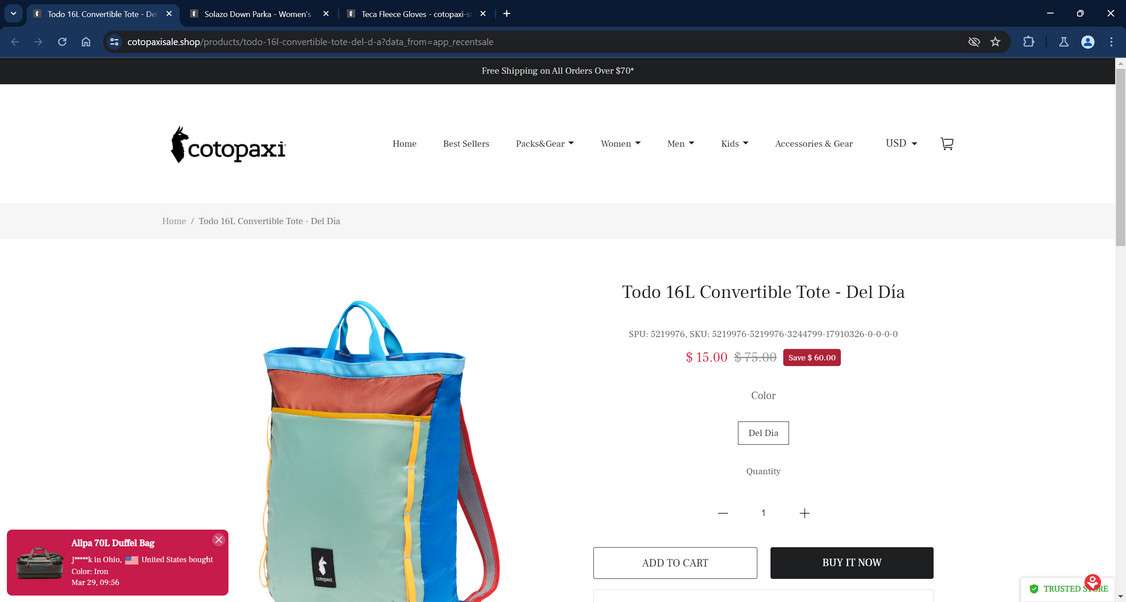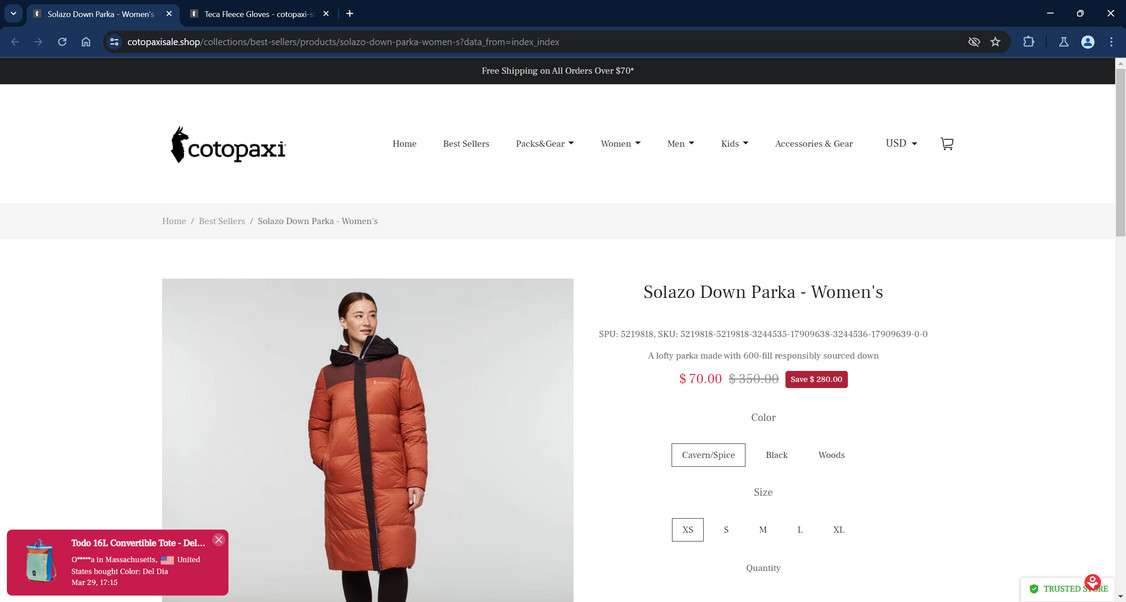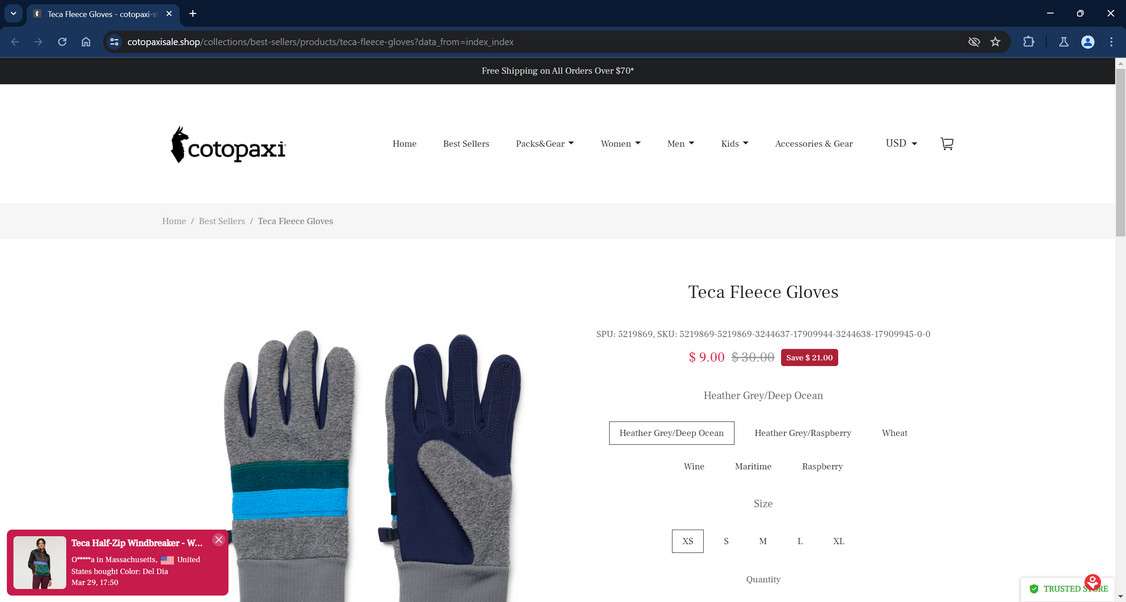Is that tempting Instagram ad for a 90% off Cotopaxi warehouse sale too good to be true? It probably is. Scammers are running rampant with fake Cotopaxi clearance sales designed to bait outdoor enthusiasts into handing over cash and personal data. Don’t get hooked by their clever schemes.
This inside look will reveal how to spot their sham sites, avoid being ripped off, and keep your hard-earned money safe. With online shopping fraud booming, it pays to be an informed consumer – starting with understanding these sneaky clearance sale scams targeting popular brands like Cotopaxi. Let’s reel in the facts on how these frauds operate, and how their false bargains can leave you empty-handed.



This Article Contains:
Overview of the Cotopaxi 90% Off Clearance Sale Scam
Outdoor apparel scammers have set their sights on Cotopaxi’s loyal fanbase, launching an elaborate scheme to rip off customers under the guise of clearance sales. They are aggressively promoting fake 90% off warehouse events, liquidation sales and other too-good-to-be-true deals through social media ads and imposter websites. Unsuspecting shoppers lured in by the prospect of unbelievably marked down jackets, fleeces, bags and gear are left empty-handed and out money in the end.
This exploitative scam is quickly proliferating across platforms like Facebook, Instagram and TikTok, finding fresh victims to target. The fraudsters have become masters at disguising their sham sites and promotions to appear as legitimate Cotopaxi sales. However, once payments are collected and personal data stolen, customers receive nothing but disappointment.
It pays to understand exactly how this scam ensnares its prey in order to avoid getting hooked yourself. Here is an in-depth look at how the deception unfolds:
Bait: Fake Websites Mimic Cotopaxi’s Branding and Products
The foundation of the scam is the development of fraudulent e-commerce websites promoting the clearance sales. To the naked eye, these sites appear convincingly like the real Cotopaxi store, from the look and feel down to copying product info, images and other branding elements. Some even use Cotopaxi in their domain name.

In reality, they are outsourced to countries like China, Vietnam or Nigeria, designed to steal money rather than sell merchandise. The sites are hosted on domains registered through obscure companies, making it easy to quickly shut down sites once word spreads.
Hook: Social Media Ads Dangle Massive Discounts
Once the fake Cotopaxi sites are ready, the fraudsters leverage social platforms to cast their bait out to the masses. Facebook and Instagram ads portraying warehouse blowouts with 70% or even 90% off are targeted at outdoor enthusiasts and existing brand followers.
They tout the events as extremely limited opportunities, using enticing slogans and eye-grabbing images of discounted gear. Some ads even impersonate influencers or brand pages to appear more legitimate. The goal is driving traffic to the sham sites.
Reel: Customers Take the Bait and Place Orders
When unsuspecting victims click on these social media ads, they are funneled to the scam Cotopaxi websites. Everything from the polished look to the familiar branding to the deep discounts creates the illusion of a real clearance sale. Customers browse the categories and eagerly fill their carts with items at $25, $35 and $45 price points.
At checkout, they enter payment information, completely unaware the site is phony. As soon as credit card details are submitted, the trap is sprung on victims. This is the endgame of the scam.
Cleaned Out: Money is Stolen, Data Harvested and Nothing Shipped
Rather than fulfilling orders, the fraudsters pilfer all credit card info entered on the site. In some cases balances are drained from accounts or used to make other unauthorized purchases. Customer data like names, emails and addresses also get compiled into lead lists, either for the scammers’ own use or possibly sold.
On the rare occasion any physical items do ship, it is scrap products like cheap bracelets clearly not matching the quality gear in ads. More commonly, absolutely nothing arrives from these phantom sites after taking payments. Customers eventually realize weeks later they have become victims of an elaborate ruse when promised items never appear.
The Catch: A Rapidly Spreading Scam Hooking More Victims
While Cotopaxi finds itself in the crosshairs of these clearance sale scams today, the fraudsters continuously switch up the brands and products being exploited through their sham websites and ads. Outdoors retailers like The North Face, Patagonia, REI and others are routinely targeted as well.
With so many eager social media users and online shoppers always searching for the next big sale event, these scammers have no shortage of potential victims to target. Staying aware of their tactics, learning to identify sham sites, and using common sense when assessing too-good-to-be-true deals is the best way to avoid taking the bait of these elaborate brand clearance scams spreading far and wide.
How the Cotopaxi Clearance Sale Scam Works
The Cotopaxi 90% off scam follows a deceptive yet straightforward playbook to rip off customers under the guise of huge markdowns. Here’s an inside look at exactly how the clearance sale sham operates.
Step 1: Scammers Create Fake E-Commerce Sites
The starting point of the scam is the development of fake e-commerce websites promoting clearance sales on Cotopaxi merchandise. The sites are designed to closely mimic the look and feel of the real Cotopaxi site, often copying images, product descriptions, branding and other content outright. However, subtle differences give away their illegitimacy upon closer inspection.
The scam sites are also hosted through domain registrars with lax oversight, making it easy for the scammers to quickly launch new sites or shut them down. They rotate domains frequently to stay one step ahead of authorities catching onto the scheme.
Step 2: Promoting the Fake Sales on Social Media
Once the sham sites are operational, scammers leverage social platforms like Facebook, Instagram and TikTok to promote their clearance sale events to large audiences.
They run paid ads targeting fans of Cotopaxi and outdoor apparel brands with tantalizing messages like “Warehouse Blowout – Up to 90% Off for Limited Time!” and images of gear marked down to $25, $35 or $45 prices.
Scammers also create accounts and posts spreading the sale news through hashtags, shares and other tactics to get the ads in front of as many potential victims as possible. The goal is generating an influx of traffic to their fake sites to complete orders.
Step 3: Customers Place Orders on the Scam Sites
When unsuspecting customers click on the social media ads or posts, they are directed to the sham Cotopaxi sales site. The well-designed pages, professional branding and steep discount prices give an air of legitimacy to the scam.
Victims browse the categories of jackets, fleeces, bags and other gear marked up to 90% off and add items to their shopping cart. At checkout, they enter personal and payment information like name, address and credit card number to complete orders.
Step 4: Collecting Payments and Customer Data
This is the end goal of the scam – using the sham sites to harvest payments and personal data from customers for criminal purposes. Once orders are placed, the scam sites immediately collect any credit card or payment details entered by victims.
Customer information like names, emails and addresses is also compiled into databases that may be used or sold by the scammers to aid future phishing and identity theft schemes.
Step 5: Never Delivering Promised Products
While some minor scam sites will send worthless items like cheap bracelets to maintain appearances, the vast majority ship absolutely nothing after collecting payments.
The products purchased by victims never arrive, and any shipping confirmation numbers provided by the sites are fake and untraceable. Customers eventually realize weeks later that they have been fleeced by the scam.
Some other variations of the scam send dirt-cheap, knockoff products clearly not matching what was advertised on the site. However, the scam’s main purpose is obtaining the payment and customer data itself versus fulfillment.
Identifying the Fakes: 8 Ways to Spot Cotopaxi Clearance Sale Scam Sites
While the fraudulent Cotopaxi sale sites are designed to look convincing, a close inspection reveals their dubious nature. Savvy online shoppers should watch for these 8 common characteristics that betray the scam sites:
1. Unbelievably High Discount Rates
The enormous 70%, 80% or even 90% off discounts trumpeted on the fake sites should immediately raise suspicions. Legitimate Cotopaxi sales offer at most 40% off – anything drastically higher is a red flag.
2. Aggressive Limited Time Messaging
Scam sites use high-pressure slogans like “Going out of business!”, “Last chance for crazy warehouse deals!” or “Today only!” to create false urgency. Cotopaxi does not hold these types of flash or closing sales in real life.
3. Missing Contact Information
While some fake sites post addresses and phone numbers, they are non-working. Generally, scam sites have no physical address, just a basic contact email if anything. This lack of legitimate contact details is telling.
4. Sloppy Grammar and Spelling Errors
Poor grammar, awkward sentences, misspellings and strange phrasing are common on the overseas-run sham sites. The real Cotopaxi site lacks these obvious language flaws.
5. Generic Stock Photos
Scammers rarely bother photographing real products, instead stealing catalog, lifestyle or placeholder images. Upon closer look, the gear in photos does not precisely match Cotopaxi’s current items.
6. Sparse, Blank or Missing Product Descriptions
Listings on scam sites often have very brief, outright missing or placeholder-style descriptions copied from the real site. There is little unique product information or imagery.
7. Recently Created Domains
Fake sites use domains registered through obscure companies mere weeks or months ago. The official Cotopaxi.com domain has a long, stable ownership history dating back years.
8. Lack of Social Media Presence
The sham sites have zero social media profiles on networks like Facebook or Instagram. Cotopaxi’s legitimate profiles have hundreds of thousands of engaged followers built up over time.
Stay alert for these telling characteristics next time an unbelievable clearance sale pops up on your feeds. Being able to discern fraudulent sites from real deals takes awareness and a finely tuned scam radar.
Social Media Red Flags: Spotting the Scam on Facebook, Instagram & TikTok
In addition to fake websites, scammers rely heavily on social media ads to promote their bogus Cotopaxi sales and lure in victims. Here are tips for identifying sham promotions on three prime platforms targeted:
Spotting Sham Sales on Facebook
- Watch for sponsored posts – Sales ads will be marked “Sponsored” and may impersonate Cotopaxi’s page.
- Too good to be true – Ad headlines boast up to 90% off, a huge red flag something is amiss.
- Suspicious URLs – The landing page URL does not match Cotopaxi’s real domain when clicked.
- Engagement proof – Scam ads have minimal comments, reactions or shares compared to the brand’s real posts.
- Report suspicious ads – Use the menu in the ad’s top right to report any likely scams to Facebook.
Cues a Cotopaxi Instagram Ad is a Scam
- Odd branding – The account name or handle lacks Cotopaxi’s distinctive branding.
- Price giveaway – Deal claims like “Jackets only $25!” are suspiciously low for a premium brand.
- Stock imagery – Photos of gear appear generic rather than official product shots.
- Follower count – Scam accounts have very low followers compared to Cotopaxi’s 665k real followers.
- Link in bio – The URL in the account’s bio directs to an unrelated, sketchy site.
Signs of a Fake Cotopaxi Promotion on TikTok
- AI voiceover – The automated voice sounds choppy and computerized.
- Stock footage – Background videos of hiking or outdoor scenes look generic.
- Website link – The site linked below doesn’t match Cotopaxi’s domain.
- Low engagement – Scam ads see little interaction in likes/comments.
- Report it – Use the Share menu to report the video as a scam or fraud.
Stay vigilant for these sketchy signals no matter the social platform. When deals seem too good to be true, sticking to official brand channels is always the smart play.
What to Do If You Ordered From a Fake Cotopaxi Site
If you placed an order on one of these Cotopaxi scam sites, take the following steps right away to limit any damage:
- File a credit card chargeback – Immediately contact your credit card company and request to chargeback any payments made to the scam site for non-delivery of goods. Provide any details of the situation. This can allow you to recover lost funds.
- Place fraud alert on credit – Put a 90-day initial fraud alert on your credit through one of the three credit bureaus. This alerts you if the scammers try opening new accounts in your name.
- Reset online account passwords – Change the passwords on any online accounts that used the same credentials entered on the scam site checkout page. Use unique, complex passwords for improved safety.
- Beware of any future scams – Scammers frequently target those who already fell for one scam for repeat offenses through phishing emails or calls. Be extra vigilant about any future contacts.
- Report the fake website – File a scam complaint at ftc.gov with details of the sham site, URL, payment method and screenshots to assist authorities.
- Spread awareness – Comment on the scammers’ social media posts and ads warning others from being defrauded by their scam sale. Post on your own social accounts as well.
Taking these proactive measures immediately after an order can greatly reduce the risk of suffering lasting impacts from this scam. Unfortunately, the odds of recovering any payments made to the sham sites are very low given their fraudulent nature.
Avoiding the Cotopaxi 90% Off Scam in the Future
While these Cotopaxi clearance scams may seem convincing with their familiar branding and huge claimed discounts, there are ways to proactively detect and avoid them:
- Research unfamiliar sites – Search for reviews and complaints before purchasing to uncover scam reports. Only buy directly from Cotopaxi.com or authorized major retailers.
- Beware social media ads – Approach sales ads on Facebook, Instagram and TikTok with skepticism no matter how legitimate they appear. Disable ad targeting in settings for extra protection.
- Look for warning signs – Study the site carefully for any of the red flags outlined earlier like extreme discounts, errors or missing contact info.
- Avoid clickbait headlines – Be extra suspicious of sensationalized slogans like “massive sale!” or “going out of business!” which scammers use as clickbait.
- Price check deals – If an advertised discount seems too good to be true, it always is. Verify against the official Cotopaxi site that prices align with real sale rates.
- Use payment protections – Never pay with risky methods like bank wires, gift cards or cryptocurrency. Stick to credit cards with strong fraud protections.
- Trust your instincts – If a site just feels a bit “off” or makes you uneasy, don’t ignore those instincts. It’s safest to avoid the potential risks altogether.
With scammers constantly cooking up new clearance sale schemes, the threats are continually evolving. Stay vigilant about any unbelievable deals, shady sites and persuasive social media pitches. If a deal really appears too good to be true, it almost certainly is.
The Bottom Line
The Cotopaxi 90% off clearance sale scam stands as a prime example of just how far fraudsters will go to rip off consumers under the guise of an unbelievable bargain. Using fake sites, stolen branding and social media hype, they lure in unsuspecting victims with the promise of jackets, fleeces and gear at a mere fraction of retail prices.
In reality, these scam sales are specifically designed to harvest payment data and steal money from customers, leaving them empty-handed in the end. With outdoor apparel scams proliferating online, it pays to exert extra caution when encountering blowout deals that seem just a bit too good to be true.
By understanding the tactical blueprint behind these frauds, identifying the warning signs of sham websites, and taking preventative security measures, shoppers can avoid being hooked by the deceptive reels cast out by clearance sale scammers. Staying focused on making purchases only through authorized retailers will help ensure you don’t get swindled by these elaborate schemes.










